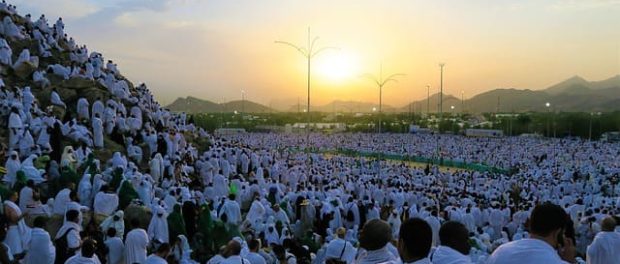Contents
Why go on pilgrimage to Mecca?
The origin of the pilgrimage to Mecca dates back to year 9 of the Muslim calendar. A crucial year in Islam corresponds to the moment when the Prophet Muhammad decided to break with Judaism and polytheism in a general way. Instead of resorting to Jerusalem as they did before, Muslims turn to Mecca. The pilgrimage always takes place between 8 and 13 of Dhul Hijja, the last month of the Islamic calendar.
If you want know about the city of meca click here
What is the Pilgrimage to Mecca?
The pilgrimage, known as Hajj, is one of the five pillars of Islam, that is, the five acts that each believer must perform. The other four pillars are: chahada, witness that nothing less than God can be worshiped and Muhammad is the prophet of God, salat, the five daily prayers, zakat, alms required by the poor in the prescribed proportions, according to their means and Siyam, fasting during the month of Ramadan.
It is mandatory to do Hajj at least once in a lifetime and only if someone meets the necessary conditions, that is to be Muslim, to be pubescent, to be mentally and financially capable of doing so. Women must be accompanied by her husband or a man from her family.
Mecca, to which Muslims turn five times a day during prayer, is the most important sacred place in the Muslim world. Hajj is above all a spiritual pilgrimage, an act of worship towards God. It is also a moment of excitement in the Muslim world, a factor of unity and exchange among Muslims around the world.
Hajj responds to a very specific protocol. Above all, it is a matter of choosing between the three types of Hajj: “Tamattou”, “Al Qiran” or “Al Ifrâd”. All correspond to different pilgrimage options, the first being the most complete.
To start the pilgrimage, you must go to one of the six Miqat, mandatory crossing points in Arabia, depending on where it comes from. Once in the Miqat, the pilgrim (man) must wear the “Ihram”. The ihram is the set of two white loincloths, but above all it is the translation of a state of ritual consecration.
Then comes the time to pronounce the sacred words that symbolize the beginning of the pilgrimage. Follow a set of specific rituals for each day. Among the most famous, on the 8th of the month, the pilgrim goes to the Al-Haram mosque for the midday prayer called “Dhor” before touring the Kaaba seven times, counterclockwise and touching the black stone.
The pilgrims will also go seven times from Safa to Marwa, two places near the Great Mosque, following in the footsteps of Hajar, wife of the Ibraham prophet, who traditionally ran between these two places to get water for his son, the prophet Ismail, until Zamzam spring sprouts at his feet.
Then they will stop precisely to drink water from the wells of Zamzam. The ninth and tenth days are dedicated to the sites of Arafat and Mina, where pilgrims symbolically steal a wake with seven stones. Before leaving, the pilgrim will have one last time to go to the Kaaba, this is called the farewell Tawaaf.
Importance of the Pilgrimage to Mecca
As described in the Quran, making the pilgrimage to Mecca is one of the five pillars of Islam instituted by Allah. In this sense, Hajj is carried out for the love of God and to be forgiven for all his past sins, In this sacred place that is the most important in the Muslim world.
The pilgrimage is one of bases and principle of the Muslim religion. It has merits and benefits that are not always understood in its fair dimension.
Among the merits are the following:
The memory of the believers of the Day of Resurrection, is significant because they leave their family, property and place of residence to meet in a place called ‘Arafat’. Therefore, they are separated from their bonds of life here in life below, they mourn their sins, fear God and submit to him and his designs.
The abolition of all differences between human beings to be at the same level. This means that the powerful and the weak are on an equal footing. So, they only have one goal, ask for God’s forgiveness and get their satisfaction. For, there is no difference between them except by faith.
The possibility that women get the reward of Jihad according to the hadith of the Prophet, informed by Aisha, may Allah be pleased with her. Also, the education of souls by learning patience in the path of Allah, because the pilgrim must sometimes perform difficult tasks in periods of great influx.
Another merit important in this case, is the opportunity to thank God for the two things he gave man in this world, money and health.
The demonstration of humility and submission to God, is considered another merit, since the pilgrim remembers the story of the prophet Ibrahim (“On him the blessing and peace”) that, in order to obey God, abandoned his family in the middle of the desert.
Difference of Pilgrimage Types in the Mecca
Hajj is the fifth principle of Islam, which makes it mandatory for any Muslim with physical and financial capacity. It is considered a duty for Allah of the people who have the means to make the pilgrimage of the house (Surah 3, verse 97).
The Umrah, commonly known as the small pilgrimage, is another form of pilgrimage to the sacred city of Mecca. In Arabic, Omra literally means “visit.” Before Islam, it was a ritual of Mecca to rain around the Kabyl Betyl. Unlike the Hajj pilgrimage, the Umrah can be done every two months of the year.
However, it is recommended to do so during the month of Ramadan. Omar Ibn Al Khattab, reported that when Jibril (‘Alayhi Salaam) asked the messenger of Allah (sallam), he said that Islam must testify there is no divinity besides Allah, and that Muhammad is his messenger, to perform the prayer, Zakat, Hajj and Umrah, in order to wash away from the state of body impurity, doing so small ablutions well and observe the fast of Ramadan.
Similarly, people who do not have the financial or physical means to perform Hajj must make another sacrifice that is easier for them. The Prophet (saas) also recommended completing the pilgrimage as soon as possible. Therefore, those who want to make the pilgrimage must hurry to do so, because they can get sick, lose their money or become impoverished.
Hajj includes all the acts of the Umrah in addition to some of its acts that are specific to him. The common points are:
In the Ihram, the pilgrim must perform his ablutions before stopping or entering a state of sacralization, it should be perfumed and perform two rakâat. The Talbiyah, is the act of intention evoked by the believer before completing the pilgrimage.
At the same time, the Tawâf, consists of turning seven times around the Kaaba. Shaving or shortening the hair, at the end of the Umrah, the pilgrim can leave his ihram (if he does not want to do Hajj). Then, men shave the skull or cut a few centimeters if they perform Hajj. Women, in turn, cut the ends of their hair. So, the Hajj pilgrimage also requires a stop at Mountain Arafat, throw stones at the Jamarates and spend the night in Mouzdalifa and Mina.
Types of pilgrimage
What is Hach or Hajj?
The pilgrim can perform 3 types of Hajj, namely: Hajj “tamatou” in which, the pilgrim chooses to make his Umrah before his Hajj. Hajj “frade”, in which, the pilgrim decides to do only Hajj and not perform the Umrah. While, the “quirane” of Hajj, the pilgrim performs Hajj and Umrah together. Learn more about Hajj in this space.
What is the Umrah?
The Umrah (or Umra), is given before entering Ihram (sacralization), so it is good to wash the body completely by doing a Ghusl (ritual bath), to shave some parts such as the armpits and pubis, to cut the nails, to carve the mustache and use perfume (musk, for example).
After having performed the Ghusl (ritual bath), the pilgrim is placed around his waist the Izar (a kind of white loincloth) and the Rida (white cloth) is placed on the upper part of his body. To put on shoes, the haj (pilgrim) will wear sandals incha Allah. It is possible to wear the robe of Ihram on the trip, before being in the Miqat, as did the Prophet and the Sahaba. Read more about the Umrah in this space.
Why do Muslims pilgrim to Mecca?
All Muslims dream of surrendering, if only once, in the sacred city of Mecca, Saudi Arabia, to perform Hajj or Umrah. The pilgrimage to Mecca, Hajj, is also an obligation that must be fulfilled at least once in a lifetime, but with a certain number of conditions.
As described in the Quran, making the pilgrimage to Mecca is one of the five pillars of Islam instituted by Allah. This pilgrimage finds these origins in the year 9 after the Hegira according to the Muslim calendar. This year corresponds to the moment when the Prophet Muhammad decided to break with polytheism and Judaism to devote his life to worship Allah.
In this sense, Hajj is carried out for the good of God and to be forgiven for all his past sins in this sacred place that is the most important in the Muslim world. Hajj also allows to know and remain united with Muslims from all over the world. In France alone, more than 50,000 pilgrims travel to Mecca every year to do Hajj or Umrah.
In this sense, all Muslims must perform Hajj Umrah at least once in their life if they have the means and if they have all the necessary conditions for it such as:
To be Muslim, that is to believe in Allah and Islam with all your heart and sincerely.
The believer must be mentally and financially fit, not forgetting to provide the resources your family needs if the Muslim runs out of them. At least having reached the age of puberty, since children can accompany their parents. However, women must be accompanied by their husbands or a man in their family (for example, their father or brother).



